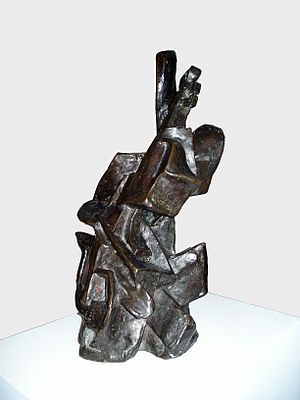- Cubist sculpture
-
Cubist sculpture is a style developed in parallel with cubist painting, centered in Paris, beginning around 1909 and evolving through the early 1920s.
The style is most closely associated with the formal experiments of Georges Braque and Pablo Picasso. Some sources name Picasso's 1909 bronze Head of a Woman as the first cubist sculpture, [1] although art historian Douglas Cooper credits the Czech sculptor Otto Gutfreund (1889–1927).
In either case, others were very quick to follow Braque and Picasso's lead in Paris, artists like Raymond Duchamp-Villon (1876-1918), whose career was cut short by his death in military service, and Alexander Archipenko, who'd arrived in Paris in 1908 and whose 1912 Walking Woman is cited as the first modern sculpture with an abstracted void, i.e., a hole in the middle [2].
Just as in cubist painting, the style is rooted in Paul Cézanne's reduction of painted objects into component planes and geometric solids (cubes, spheres, cylinders, and cones). According to Herbert Read, this has the effect of "revealing the structure" of the object, or of presenting fragments and facets of the object to be visually interpreted in different ways. Both of these effects transfer to sculpture. The distinction between "analytic cubism" and "synthetic cubism" also holds true in sculpture. "In the analytical Cubism of Picasso and Braque, the definite purpose of the geometricization of the planes is to emphasize the formal structure of the motif represented. In the synthetic Cubism of Juan Gris the definite purpose is to create an effective formal pattern, geometricization being a means to this end." [3]
By the early 1920s, significant Cubist sculpture had been done in Sweden (by sculptor Bror Hjorth), in Prague (by Gutfreund and his collaborator Emil Filla), and at least two dedicated "Cubo-Futurist" sculptors were on staff at the Soviet art school Vkhutemas in Moscow (Boris Korolev and Vera Mukhina). Other significant cubist sculptors include Jacques Lipchitz and Henri Laurens.
The movement had run its course by about 1925, but cubist approaches to sculpture didn't end as much as they became a pervasive influence, fundamental to the related developments of Constructivism and Futurism.
See also
References
- ^ Grace Glueck, Picasso Revolutionized Sculpture Too, NY Times, exhibition review 1982 Retrieved July 20, 2010
- ^ http://www.kodnergallery.com/gallery/modernism/bios/archipenkobio.html
- ^ Herbert Read, A Concise History of Modern Sculpture
Categories:- Sculpture
- Art movements
- Modern art
- Cubism
Wikimedia Foundation. 2010.


